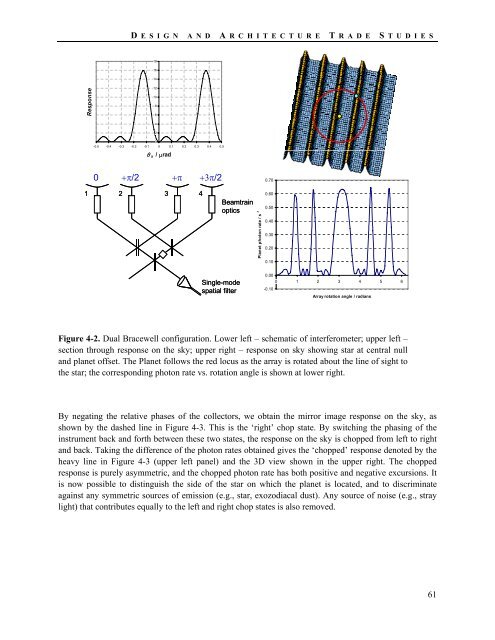TPF-I SWG Report - Exoplanet Exploration Program - NASA
TPF-I SWG Report - Exoplanet Exploration Program - NASA
TPF-I SWG Report - Exoplanet Exploration Program - NASA
Create successful ePaper yourself
Turn your PDF publications into a flip-book with our unique Google optimized e-Paper software.
D ESIGN AND A R C H I T E C T U R E T RADE S TUDIES<br />
18<br />
16<br />
14<br />
Response<br />
12<br />
10<br />
8<br />
6<br />
4<br />
2<br />
0<br />
-0.5 -0.4 -0.3 -0.2 -0.1 0 0.1 0.2 0.3 0.4 0.5<br />
θ x / μrad<br />
0 +π/2 +π +3π/2<br />
0.70<br />
1 2 3 4<br />
Beamtrain<br />
optics<br />
Planet photon rate / s -1<br />
0.60<br />
0.50<br />
0.40<br />
0.30<br />
0.20<br />
0.10<br />
Single-mode<br />
-0.10<br />
spatial filter<br />
0.00<br />
0 1 2 3 4 5 6<br />
Array rotation angle / radians<br />
Figure 4-2. Dual Bracewell configuration. Lower left – schematic of interferometer; upper left –<br />
section through response on the sky; upper right – response on sky showing star at central null<br />
and planet offset. The Planet follows the red locus as the array is rotated about the line of sight to<br />
the star; the corresponding photon rate vs. rotation angle is shown at lower right.<br />
By negating the relative phases of the collectors, we obtain the mirror image response on the sky, as<br />
shown by the dashed line in Figure 4-3. This is the ‘right’ chop state. By switching the phasing of the<br />
instrument back and forth between these two states, the response on the sky is chopped from left to right<br />
and back. Taking the difference of the photon rates obtained gives the ‘chopped’ response denoted by the<br />
heavy line in Figure 4-3 (upper left panel) and the 3D view shown in the upper right. The chopped<br />
response is purely asymmetric, and the chopped photon rate has both positive and negative excursions. It<br />
is now possible to distinguish the side of the star on which the planet is located, and to discriminate<br />
against any symmetric sources of emission (e.g., star, exozodiacal dust). Any source of noise (e.g., stray<br />
light) that contributes equally to the left and right chop states is also removed.<br />
61
















